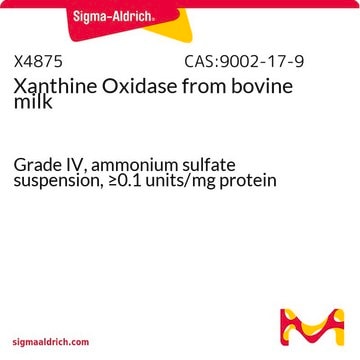X1875
Xanthine Oxidase from bovine milk
Grade I, ammonium sulfate suspension, ≥0.4 units/mg protein
Sinónimos:
XOD, Xanthine:oxygen oxidoreductase
About This Item
Productos recomendados
tpo
Grade I
formulario
ammonium sulfate suspension
actividad específica
≥0.4 units/mg protein
actividad extraña
uricase ≤0.5%
Condiciones de envío
wet ice
temp. de almacenamiento
2-8°C
¿Está buscando productos similares? Visita Guía de comparación de productos
Descripción general
Aplicación
- in the preparation of xanthine oxidase (XO) solution for 5-(diethoxyphosphoryl)-5-methyl-1-pyrroline-N-oxide (DEPMPO)-spin trapping assay
- in in vitro XO assay for screening Vietnamese medicinal plants for XO inhibitory activity
- as a standard to determine XO activity
- as a standard to test the synergistic effect of docosahexaenoic acid (DHA)
Acciones bioquímicas o fisiológicas
Definición de unidad
Forma física
Nota de análisis
Palabra de señalización
Danger
Frases de peligro
Consejos de prudencia
Clasificaciones de peligro
Resp. Sens. 1
Código de clase de almacenamiento
11 - Combustible Solids
Clase de riesgo para el agua (WGK)
WGK 3
Punto de inflamabilidad (°F)
Not applicable
Punto de inflamabilidad (°C)
Not applicable
Equipo de protección personal
Eyeshields, Gloves, type N95 (US)
Certificados de análisis (COA)
Busque Certificados de análisis (COA) introduciendo el número de lote del producto. Los números de lote se encuentran en la etiqueta del producto después de las palabras «Lot» o «Batch»
¿Ya tiene este producto?
Encuentre la documentación para los productos que ha comprado recientemente en la Biblioteca de documentos.
Los clientes también vieron
Artículos
Instructions for working with enzymes supplied as ammonium sulfate suspensions
Protocolos
Enzymatic Assay of Superoxide Dismutase
Nuestro equipo de científicos tiene experiencia en todas las áreas de investigación: Ciencias de la vida, Ciencia de los materiales, Síntesis química, Cromatografía, Analítica y muchas otras.
Póngase en contacto con el Servicio técnico












